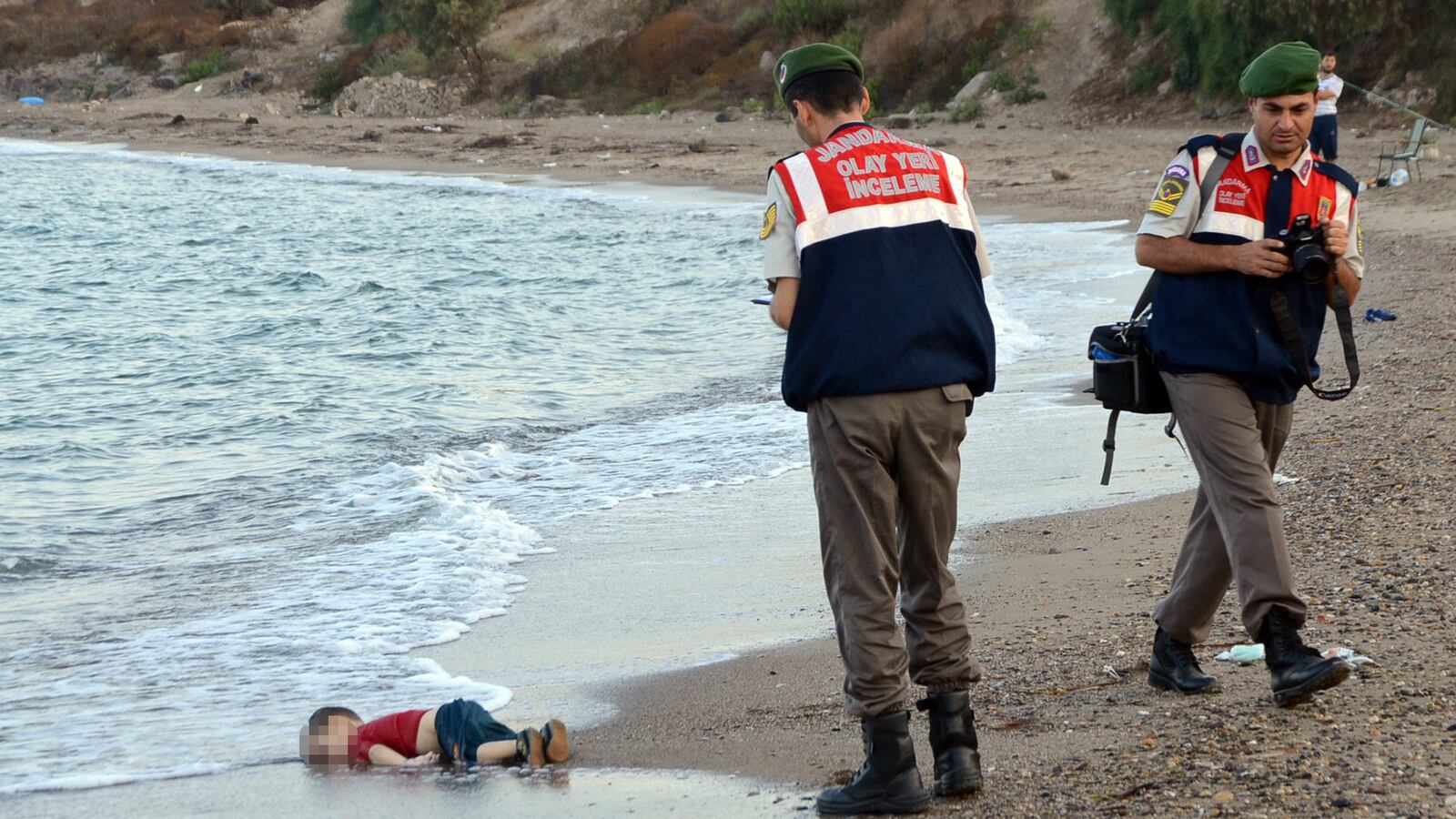Do not look closely at the photographs here. Do not look at them at all. They will, in an instant, inspire pity, revulsion, anger and calls to “do something…now!”
How else might one react to photographs of toddlers washing up in the waves that lap the Libyan shore? Or for that matter the tangle of bodies, as twisted and tortured as those piled into the mass graves of Nazi death camps, crammed instead into the back of a truck in Austria to die, and not of Zyklon B, but of suffocation? There are many children among them as well, indistinguishable in the mass of rotting flesh. And there will be more. A photograph of a little boy washed up on a Turkish beach has gone viral with the hashtag #KiyiyaVuranInsanlik. The slaughter of the innocents continues day after day.

There is something obscene here. Shall we call it disaster porn? That is too easy, because that lets us compartmentalize the horror and lets us do what we really want to do with it: forget about it. “Wasn’t that horrible?” is always easier to say that than to say what is the truth, “This is grotesque and horrifying and it’s only the beginning.”
The people at Migrant Report, the Malta-based nongovernmental organization that published the snapshots of dead infants on a Libyan beach under the headline “The Pictures That Need to Be Seen,” clearly wanted to provoke a reaction.
“I contemplated publishing those pictures for 24 hours,” says the newsletter’s editor, Mark Micallef. “In the end, the answer I gave myself is that we respect the dignity of those children more by publishing the photos of their bodies than by not publishing them. If the pictures move a single politician holding an unhelpful position, their death would not have been completely in vain.”
The dead babies in Libya are, according to Migrant Report, the victims of the latest tragedies off the shores of Zuwara, a town on the coast about 40 miles west of Tripoli that is known as a major point of departure for migrants and refugees wanting to reach Europe by boat. A boat sank over the weekend with more than 430 people aboard. Only 180 survived; only 111 cadavers were found; among those were the five little kids in the photographs.
“This tragedy has shaken the community,” Ibrahim Gibara, an official of the Zuwara municipality, told Migrant Report. “We are not for this, we are against it. When you see the bodies of small children, it’s just too much.”
A day later, as the world awoke to photos of the three-year-old Syrian boy, Aylan Kurdi, inert on the sands of Turkey, that sentiment spread around the globe.
What’s needed to stop this grim tide is not more warships in the Mediterranean interdicting smugglers’ boats, not more water cannons at the borders of the Balkans. In the medium term, as Micallef says, “the solution lies in managing migration from Africa and the Middle East into Europe by providing legal avenues for asylum seekers in transit countries. I feel Europe should also extend this to economic migrants, given its aging population and the labor crisis facing some of its better performing economies, but I recognize that we are light-years away from this.”
“The point is that this is the only realistic way Europe can begin to harm the ‘smugglers’ business model,’ says Micallef. “As long as there is a demand for the service smugglers offer, people will keep taking risks by entrusting their lives to ruthless profiteers exploiting people’s misery all along the migration routes. Will that stop people crossing the desert or getting on rickety boats? No, it likely won’t, but it will reduce the numbers dramatically.”
Beyond that, what’s needed is a fundamental rethink of the comfortable assumptions of the comfortable people in the West (the 1 percent and then some) who believe that they can rake in obscene amounts of money all for themselves and build walls to keep out those who want to earn a decent living by crossing the frontiers, however they can, of those modern promised lands known as the European Union and the United States.

(Thank you, Donald Trump, for opening to public debate this ridiculous notion of a wall on the Mexican border. Thank you, Scott Walker, for raising the ante by suggesting a wall with Canada as well as Mexico, an argumentum ad absurdum that may help define a risible candidacy.)
No contemporary Canute can beat back the waves upon waves of desperate people, and there is no quick way to stop the riptide that pushes the inert corpses of children back against the shores of Libya like the spit of the sea.
Ad hoc measures will be taken here and there, as we have seen, but they will do little more than displace the flood, not stop it:
The boats pushing into the Med from North Africa were never very seaworthy, but now they have to be completely expendable, ready to be seized, and to be written off, or to sink and be written off, by the gangs that launched them leaking and overloaded in the first place.
Close the borders with the Balkan states, and refugees climb into sealed trucks like that putrid 18-wheeler in Austria.
The only medium- and long-term solution for this horrific global problem is to build peace in the war zones of Syria, Afghanistan, and Somalia—the three countries that account for more than half of the world’s refugees; impose order on the chaos of Libya; deliver some modicum of freedom and prosperity in West and East Africa; and greater social and economic justice in Latin America.
To do that requires reliable long-term policies to promote development and good governance, not just the tossing of a few millions of dollars or euros here or there, or preaching about a system of globalized free trade that has made the rich so much richer and the poor, by comparison, so much poorer.
(The preaching of Pope Francis, in fact, makes the problem abundantly clear when he talks about a “culture of waste” in modern consumer society that threatens the global environment and the lives of countless individuals.)
There is little in our experience in the last 50 years that suggests that such policies will materialize. We Americans may fight trillion-dollar wars, but we begrudge every dollar in global foreign aid, which represents less than 1 percent of the multi-trillion-dollar U.S. budget.
Europe gives a bit more money to its southern neighbors, but has not yet found ways to give them hope. And when the refugees come, the ability to integrate them into countries that never claimed to be, nor wanted to be, nations of immigrants is extremely limited. They are seen not as human capital for the future in the ossifying, geriatric societies of the West, but as perpetual burdens on society to be kept in legal and social purgatory, a self-fulfilling prophecy if ever there was one.
So, do not look at these pictures. Things could be done to avoid such tragedies in the future, but those things won’t be done. We will build walls, we will deploy fleets, and we will turn away when the lifeless children wash up on those distant shores.
Editor's Note: This story has been updated.






